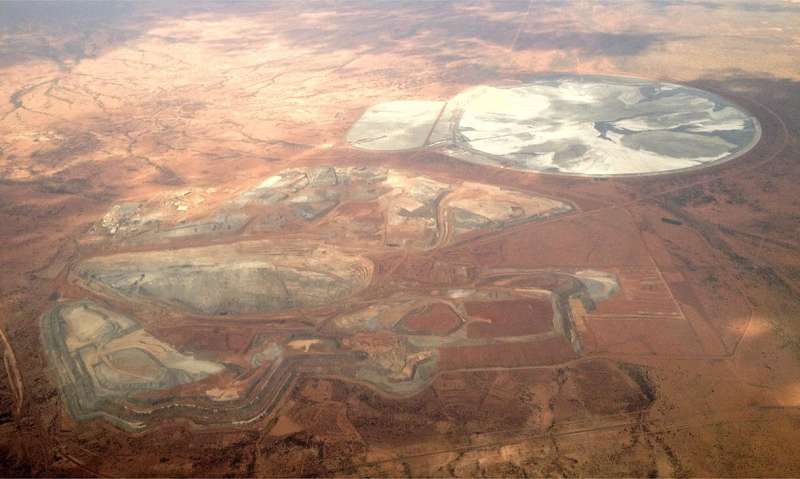Mining atlas helps map Australia’s clean energy future
The Atlas of Australian Mine Waste was launched this week by Geoscience Australia in partnership with RMIT and University of Queensland researchers and geological surveys across the country.
The online resource maps sites across Australia that could contain previously overlooked critical minerals—including those used to produce electric vehicles, batteries and solar panels.
Minister for Resources and Northern Australia, Madeleine King, said the new atlas could provide industry with additional opportunities to extract valuable resources from previously mined rock and earth.
“Some of the minerals we need now, and into the future, may not just be in the ground—they’re also in rock piles and tailings on mine sites around the country,” King said.
“These minerals might not have been of interest when first extracted but could now be in hot demand as the world seeks to decarbonize—for example, cobalt in the tailings of old copper mines.”
Project Lead from RMIT, Associate Professor Gavin Mudd, said based on databases from his research the Atlas identified 1,050 sites across Australia as possible sources of critical minerals, with more to be added in future.
“This is the first time in the world that any nation has mapped all of their tailings dams and developed information on them,” said Mudd, from RMIT’s School of Engineering.
“These tailings could be reprocessed to extract critical minerals—those fundamental to modern technologies such as renewable energy, energy storage batteries and other technologies—and do so with much less environmental impact than developing a new mine.”
“Tailings reprocessing could therefore become a sustainable and responsible supply for critical minerals and help to achieve better long-term environmental outcomes at each mine.”
Future research is aimed at exploring the geochemistry of tailings and the potential for critical minerals, as well as the environmental benefits of reprocessing old mine waste such as tailings. The new atlas provides the most comprehensive basis in the world to conduct such research.
Citation:
Mining atlas helps map Australia’s clean energy future (2023, June 1)
retrieved 1 June 2023
from https://phys.org/news/2023-06-atlas-australia-energy-future.html
This document is subject to copyright. Apart from any fair dealing for the purpose of private study or research, no
part may be reproduced without the written permission. The content is provided for information purposes only.

The Atlas of Australian Mine Waste was launched this week by Geoscience Australia in partnership with RMIT and University of Queensland researchers and geological surveys across the country.
The online resource maps sites across Australia that could contain previously overlooked critical minerals—including those used to produce electric vehicles, batteries and solar panels.
Minister for Resources and Northern Australia, Madeleine King, said the new atlas could provide industry with additional opportunities to extract valuable resources from previously mined rock and earth.
“Some of the minerals we need now, and into the future, may not just be in the ground—they’re also in rock piles and tailings on mine sites around the country,” King said.
“These minerals might not have been of interest when first extracted but could now be in hot demand as the world seeks to decarbonize—for example, cobalt in the tailings of old copper mines.”
Project Lead from RMIT, Associate Professor Gavin Mudd, said based on databases from his research the Atlas identified 1,050 sites across Australia as possible sources of critical minerals, with more to be added in future.
“This is the first time in the world that any nation has mapped all of their tailings dams and developed information on them,” said Mudd, from RMIT’s School of Engineering.
“These tailings could be reprocessed to extract critical minerals—those fundamental to modern technologies such as renewable energy, energy storage batteries and other technologies—and do so with much less environmental impact than developing a new mine.”
“Tailings reprocessing could therefore become a sustainable and responsible supply for critical minerals and help to achieve better long-term environmental outcomes at each mine.”
Future research is aimed at exploring the geochemistry of tailings and the potential for critical minerals, as well as the environmental benefits of reprocessing old mine waste such as tailings. The new atlas provides the most comprehensive basis in the world to conduct such research.
Citation:
Mining atlas helps map Australia’s clean energy future (2023, June 1)
retrieved 1 June 2023
from https://phys.org/news/2023-06-atlas-australia-energy-future.html
This document is subject to copyright. Apart from any fair dealing for the purpose of private study or research, no
part may be reproduced without the written permission. The content is provided for information purposes only.
